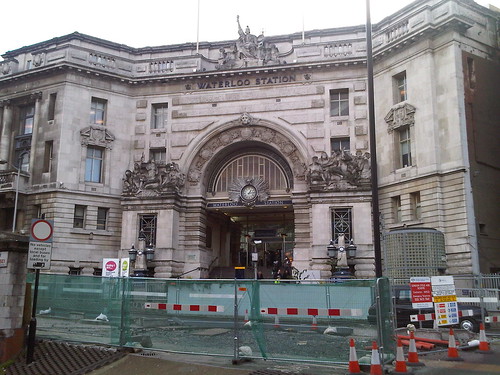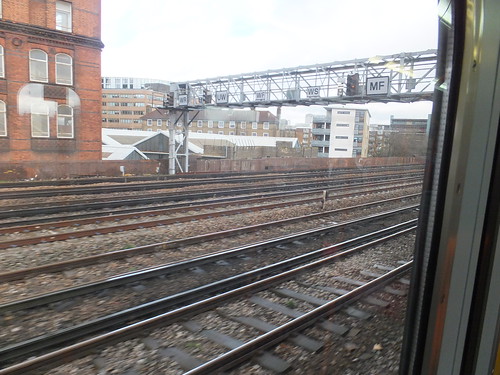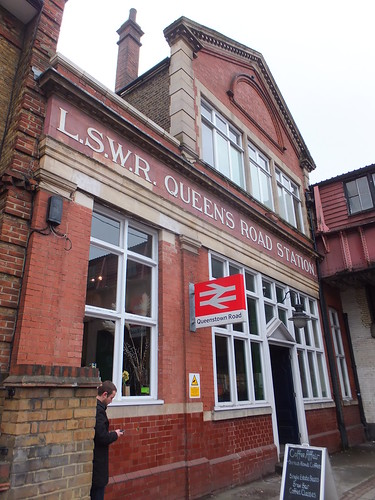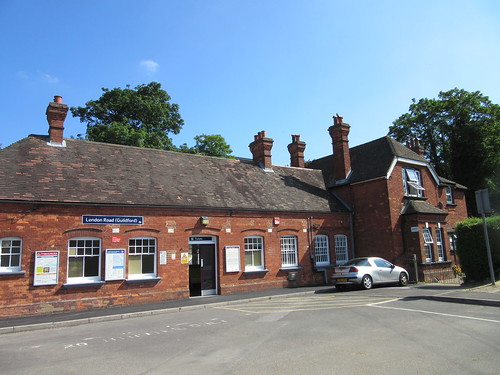 A modern view of the former L.S.W.R. London terminus at Waterloo showing the imposing main entrance for foot passengers, rather spoilt by the temporary works in the foreground. After the 'Great War' of 1914-1918, this entrance became the Memorial to L.S.W.R. staff lost in World War I.
A modern view of the former L.S.W.R. London terminus at Waterloo showing the imposing main entrance for foot passengers, rather spoilt by the temporary works in the foreground. After the 'Great War' of 1914-1918, this entrance became the Memorial to L.S.W.R. staff lost in World War I.
I was brought up in the Midlands in the early days of the post-war Nationalised railway so, although I was familiar with both the former L.M.S. and G.W.R. lines, the former Southern Railway was very much a 'foreign railway' to me. It was some time before I started to discover some of the history of the lines in the south of the country.
Upon Nationalisation in 1948, the Southern Region of British Railways absorbed the assets of the Southern Railway. The Southern Railway had been created in 1923 by the government-directed grouping of railways into the 'Big Four' (L.M.S., G.W.R., L.N.E.R. and S.R.). The Southern Railway brought together the London Brighton and South Coast Railway, the South Eastern and Chatham Railway and the London and South Western Railway.
Brief early history of the London and South Western Railway
I've mentioned some early railways in England in the post here and this mentions the origins of the London and South Western Railway. The success of the Liverpool and Manchester Line which opened in 1830 encouraged the promotion of the London and Southampton Railway as early as 1831. A limited service started on 21st May 1838 between a London terminus at Nine Elms and Woking Common. As construction of the line towards Southampton continued, the name of the railway was changed to the more impressive-sounding 'London and South Western Railway'. I believe this was to avoid offence to the people of Portsmouth (who considered Southampton a modern upstart) as the railway planned an extension to Portsmouth. The railway used this new name (or the contraction 'South Western Railway' or simply the 'South Western') without change or amalgamation until the Grouping in 1923.
The initial route to Southampton was opened throughout in 1840. A branch to Richmond was opened in 1846 but the growing traffic showed up the inadequacy of Nine Elms as a terminus. An extension was authorised from Nine Elms to a new station near the south end of Waterloo Bridge.
Both the new line, (which, ambitiously, had four lines from the start) and the new station, called 'Waterloo', were raised on arches. On the 4-track extension over the arches, the western pair of lines were used for Richmond Line Trains. The Richmond line was extended to Windsor in 1849 and the term 'Windsor Lines' was coined for the western pair of lines. Today, there are eight running lines into Waterloo but the western group are still the 'Windsor Lines'.
 View from Up train approaching Waterloo. L-R: Windsor Reversible, Up Windsor, Windsor Fast, Windsor Slow, Main Fast.
View from Up train approaching Waterloo. L-R: Windsor Reversible, Up Windsor, Windsor Fast, Windsor Slow, Main Fast.

A modern view of Waterloo Station (centre) with Hungerford Bridge leading to Charing Cross station towards the top. Although the station and rail approaches are much extended, the way in which the line from Nine Elms was extended over arches is still apparent. On the north bank of the Thames note the Palace of Westminster (left), Whitehall and Trafalgar Square with Nelson's Column (right).
In 1848, Nine Elms was closed to the public (although retained for Royal Trains and goods) when all passenger traffic was diverted to Waterloo. The initial Waterloo Station had four platforms with two 'middle lines'. The L.S.W.R. intended to extend the line beyond Waterloo to get nearer to the City of London, which was the ultimate destination for many of its regular passengers. As a stop-gap, one of the 'middle lines' was extended to form a through connection with the South Eastern Railway (later to become the S.E.C.R.) but today there's only a pedestrian connection between the terminal platforms at Waterloo and the through platforms at Waterloo East. As an alternative, the L.S.W.R. supported the initiative to build an underground electric railway from Waterloo to the City. From the line's opening in 1898, the L.S.W.R. operated the railway on behalf of the Waterloo and City company, but it later acquired ownership outright. There's a little more on the Waterloo & City Line in the article here.

Queenstown Road station, opened 1877 on the extension to Waterloo, still proudly displays its L.S.W.R. origins and its original name, Queen's Road Station.
 Click for larger image.
Click for larger image.
Details of the junctions between the L.S.W.R. and other railways in the vicinity of Clapham Junction. This diagram is one of a series prepared by the Railway Clearing House in 1914 which appear in the reprint 'Pre-Grouping Railway Junction Diagrams 1914', published by Ian Allen (ISBN 0 7110 1256 3).
 The attractive station building provided at London Road (Guildford).
The attractive station building provided at London Road (Guildford).
Ultimately, the reach of the L.S.W.R. extended to the far west, covering Exeter, Plymouth, Padstow, Bude and Ilfracombe.
The section 'Related articles in this blog' (below) lists other posts concerning the L.S.W.R. around London.
Books
[1] 'The London & South Western Railway' O.S. Nock, published by Ian Allen.
[2] 'Locomotives of the London and South Western Railway Part 1' by D.L. Bradley, published 1965 by RCTS.
[3] 'The South Western Railway' by Hamilton Ellis, published 1956 by George Allen and Unwin.
[4] 'History of the Southern Railway' by C. F. Dendy Marshall, revised by R. W. Kidner reprinted 1982 by Ian Allen (ISBN 0 7110 0059 X).
[5] 'Great Locomotives of the Southern Railway' by O. S. Nock, Guild Publishing, 1987 edition by Book Club Associates.
[6] 'Southern Steam' by O. S. Nock, published by David & Charles (ISBN 0 7153 5235 0).
[7] 'London's Termini' by Alan A. Jackson, published by David & Charles (0 330 02746 6). (The L.S.W.R. Terminus at Waterloo is described in Chapter 11).
[8] 'Southampton's Railways' by Bert Moody, Waterfront Publications (ISBN 0 946184 63 1).
Maps
Details of what remains of the L.S.W.R. today are shown in two sections of the 'Quail Track Diagrams':-
'Railway Track Diagrams Book 5: Southern and TfL' Third Edition, published by TRACKmaps (ISBN 978-0-9549866-4-3).
'Railway Track Diagrams Book 3: Western' Fourth Edition, published by TRACKmaps (ISBN 0-9549866-1-X).
External Links
London and South Western Railway (Wikipedia).
Related articles in this blog
Waterloo Station, London.
Waterloo Station, London (Part 2).
London Underground: The Waterloo & City Line.
Clapham Junction Station, London.
By Rail to Guildford.
My Pictures
These are albums which include pictures taken in recent times showing former L.S.W.R. infrastructure:-
Clapham Junction.
London: former 'Southern' lines.
London's Railways.
Waterloo Station.
skip to main |
skip to sidebar

The occasional and probably unreliable recollections of an aging female.

About Me
- Jan Ford
- Jan passed away on 13 July 2024.
Jan's blog will be maintained, both in her memory and also as a source of reference material in many areas of interest. New posts will be added, to continue to record the ongoing influence of Jan's work and life.
Jan:
I've been an electronics engineer for over 57 years and I'm interested in travel, history, architecture, the industrial revolution, science, railways and, well, lots of things. I believe in what one of my heroes, Richard Feynman, called "The Pleasure of Finding Things Out".
'Labels to select a blog topic' (below) will select the posts on a particular subject.
The Search Box (with the magnifying glass symbol) in the header will find posts including any particular word or phrase.
'Links to photographs' (below) will take you directly to my photographs on 'Flickr'.
You can contact me at jan.c.ford@gmail.com.
Labels to select a blog topic
- Antarctic Peninsula (8)
- Australia-2017 (10)
- Battlefield Line (98)
- Brewood Hall (48)
- Burma-2012 (21)
- Burma-2014 (21)
- Burma-2015 (20)
- Burma-2016 (25)
- Burma-2017 (24)
- Burma-2017(2) (20)
- Burma-2018 (24)
- Burma-2019 (17)
- CA1 (1)
- Caledonian-Sky (23)
- Caspian Odyssey (11)
- CH1 (2)
- Charity Work (76)
- Chilean Fjords (22)
- China (17)
- DMU (23)
- Education (72)
- Engineering (24)
- FE1 (1)
- FE2 (22)
- FE3 (27)
- FE4 (25)
- FE5 (12)
- FE6 (25)
- Flying (8)
- Heritage (94)
- Index (10)
- Istanbul (4)
- j1 (16)
- Loco-profile (12)
- London Underground (6)
- Malta (8)
- ME1 (21)
- Medical Support (48)
- Merseyside (50)
- MIC (70)
- model railways (25)
- MOSI (28)
- Music (4)
- Myanma-Railways (75)
- Myanmar (2)
- Nepal (6)
- New York (7)
- None of the above (78)
- NW1 (13)
- OLCO (44)
- Peak Rail (68)
- Railway Signalling (203)
- Railways (719)
- RTW1 (3)
- RTW2 (1)
- RTW3 (1)
- RTW4 (31)
- RTW5 (29)
- Russian-railways (15)
- safari (28)
- Sam (3)
- Santa Specials (17)
- South Atlantic Voyage (19)
- Telecomms (8)
- Thomas (12)
- Tibet (9)
- Traffic Movements (42)
- Trans-Siberian (17)
- Travel (681)
- Trip to Burma (11)
- Trip to Russia (19)
- Trip to St. Helena (9)
- Tropic of Capricorn (17)
- Ty Gwyn (15)
- Tyseley (4)
- Work (36)
Blog Archive
- ► 2014 (102)
- ► 2013 (153)
- ► 2012 (151)